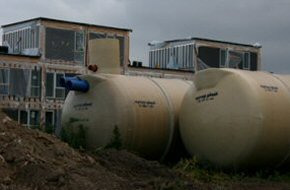WSUD at Stenløse Syd
In Stenløse Syd, rainwater is collected for WC flushing and laundry purposes. Surplus water is infiltrated.
In Stenløse Syd, there is an urban development area for a total of 750 homes (350 established in early 2009) which states in local plans that all rainwater from roofs and paved areas must be kept on its own land. This means that 70% (not from roads or parking spaces) of the total rainwater volume in the area is reused or infiltrated.
Rainwater from roof areas must be collected and used for flushing toilets, and many families have also opted to use the rainwater for laundry purposes (approx. 40% of household water consumption). Surplus water must be infiltrated in a soakaway on its own land.
Water from roofs of each individual house is fed via "dry" pipes to a rotary filter which filters out particles greater than 0.44 mm (leaves, sand, gravel, etc.). The filtered rainwater is stored in an underground tank which is also used to separate out finer particles. When the rainwater has been filtered, stored below 18 ºC (in practice 9-12 ºC) and away from light, water quality is not impaired over time. Overflow from the storage tank (3-5 times per year) is fed via a gully with a sludge trap to a soakaway, which is designed in accordance with danish guidelines.
On an annual basis, the rotary filter collects approx. 90% of the rainwater from the roof surface and must generally be cleaned 4 times a year.
Statement from Kenneth Lund, Nyrup Plast: There are a number of advantages to this solution. All rainwater is kept on the private plots, and the landowner pays no charges for the public sewage system for treatment of rainwater. Quite the opposite: this is a private financial investment which helps to protect groundwater and reduces the municipality's need to treat rainwater, as well as reducing the stormwater load on the Værebro river (recipient)
Consumption of drinking water from waterworks is reduced considerably, and as rainwater is "soft" water it is possible to reduce the use of detergents and fabric softeners for laundry purposes. Furthermore, use of descaling agents in washing machines and toilets is not necessary (A 1 mm deposit of limescale on a heating element increases energy consumption by approx. 10%).
The disadvantages are that the cost of construction for detached houses is relatively high. Return on Investment times are relatively long, but they are reduced by means of increasing water prices and waste water charges.
When constructing terraced houses, the Return on Investment times are significantly shorter as a result of economies of scale.
Establishment costs
Approx. DKK 40,000, ex. VAT. (rainwater system per detached house / excl. soakaway).
A set water drainage charge is levied for rainwater for 10 m³.
Operation and maintenance
The rotary filter is generally cleaned 4 times a year so as to ensure the best possible utilisation of the rainwater resources.
The rainwater tank is emptied and cleaned once every 5 – 10 years in order to avoid sediment in the water.
The gully with the sludge trap must be cleaned occasionally to prevent blockage of the soakaway.
Contacts
Name: Kenneth Lund
Organisation: Nyrup Plast
E-mail: kl@nyrupplast.dk
Telephone: +45 57 80 31 00
Photo

